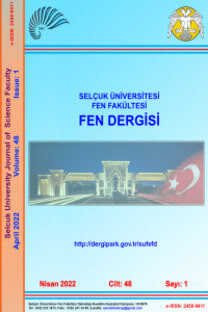Isısal uyarımlı süreçler için programlanabilir bir düşük sıcaklık kontrol sisteminin tasarımı ve yapımı
Malzeme parametrelerinin sıcaklıkla değişiminin incelendiği ısısal uyarımlı süreçlerde (ITC), $\beta$=dT/dt ısıtma hızı kontrolü değişik şekillerde gerçekleştirilebilir. Isıtma hızlarının (Lineer, Parabolik, Hiperbolik ve Ters) şekli, sonuçların değerlenmesinde çeşitli kolaylıklar sağlamaktadır. Isıtma hızının kontrolünü sağlayan ilk devreler katı elektronik devre tasarımlarına dayanmaktayken zamanla bilgisayar sistemlerindeki gelişimine paralel olarak ısısal kontrol işlevi de bilgisayarlarla yapılmaya başlanmıştır. Bu çalışmada, ısıtma hızı kontrolünün bilgisayar ile sağlandığı ve sonuçların geniş analiz esnekliği içerisinde değerlendirilebildiği bir sistem tasarlanarak gerçekleştirilmiştir. Sistemin kalibrasyonu yapıldıktan sonra Seydişehir Alüminyum tesislerinden alınan farklı ticari Alüminyum numuneler üzerinde özdirencin sıcaklıkla değişimi dört nokta yöntemi ile elde edilmiştir. Sonuçlar oldukça tatmin edici bulunmuştur.
Design and construction of a programmable low temperature controller system for thermally stimulated proceses
In the thermally Stimulated Processes, where the control of heating rate $\beta$=dT/dt = f(t)) is very important, this control may be achieved by various techniques. The magnitude and the shape of heating rate (i.e. linear, parabolic, hyperbolic ...) are important for either the observation or evaluation of different phenomena. A proper choice of heating rate may lead to significant simplifications. Early electronic circuits used to control the heating rate were robust circuits, then following the development of PC's the heating rate was also controlled by PC's. In this study, instead of using solid electronic control circuits, we have considered the flexibility offered by computers, and a PC based control system is designed for realizing the low temperature control system. In order to test this system, the change of electrical resistivity with temperature was measured for various commercial aluminum samples obtained from Seydişehir Aluminum plant. The results have found very satisfactory.
___
1. Bayard, J., Grenet. J., Cobat. C., Dargent, E., Thermally stimulated depolarisation current measurements and interpretation. IEE Prac.-Sci.Meas, Technol., 144:168-173 (1997).2. Özdemir, S., Bozkurt, A., Design and realization of apparatus for thermally stimulated current studies. Doğa 11:180 (1967).
3. Mariani, D.F., Vignola, J., A simple unit with temperature control for simultaneous measurement of thermoluminescence and conductivity. J. Phys, E, 15: 990-991 {1982).
4. Mills, A.A., Sears, D.W., Hearsey, R., Apparatus for the measurement of thermoluminescence. J. Phys. E. 10:51-56(1976).
5. Ronarch, D, Testard, O., A simple apparatus to measure thermally stimulated depolarisation currents above 5 K. J. Phys. E: Sci. Instrum., 15:636-638 (1982).
6. Ayev, T., PC tabanlı veri toplama ve kontrol sistemleri I. Otomasyon 63. İstanbul (1997).
7. Ayev, T., PC tabanlı veri toplama ve kontrol sistemleri II. Otomasyon 64. İstanbul (1997).
8. Gmelin, E., Alpen, U.v., A new simple variable-temperature cryostat., Fifth international cryogenic engineering conference (ICEC5), Germany (1975).
9. Wolfgang R., Güçlü ve Kararlı, Pratik Devreler: Elektronik dergisi, cilt 3, sayı 33 : 39-42 (1992).
10. Mc Jeever S.W.S., Hughes D.M., Low temperature space charge polarization in alkali halide crystals. J. Phys. Chem. Solids. 39:211-219 (1977).
11. Ryuji T., Keiko K., Takayuki A., Shin T., Electrical properties of approximant phases in AI-Pd-{Fe, Ru) system.Materials Science and Engineering 294-296:607-610 (1999).
12. Ivkov J., and Radic N., The electrical resistivity in Al-W amorphous alloys. Solid state Communications, Vol. 106 No. 5 :273-277 (1998).
- ISSN: 1300-4905
- Yayın Aralığı: Yıllık
- Başlangıç: 2018
- Yayıncı: -
Sayıdaki Diğer Makaleler
The almost Hilbert-Smith matrices on Gcd-closed sets
Hamam böceklerinin (Blattodea: Blattidae) patojen bakteriler yönünden araştırılması
Yusuf DURAK, Cihan ERTÜRK, Birol ÖZKALP, Rüstem DUMAN
HAZİRET DURMUŞ, Haldun KARABIYIK
On pre-open and M pre-open functions
Şaziye YÜKSEL, Ahu AÇIKGÖZ, Aynur KESKİN
On a LOD and Crank-Nicolson methods for the two dimensional diffusion equation
On the bounds of norms of circulant Cauchy-Toeplitz matrices
Süleyman SOLAK, Durmuş BOZKURT
ERCAN ALTINIŞIK, Şuur NİZAMOĞLU
